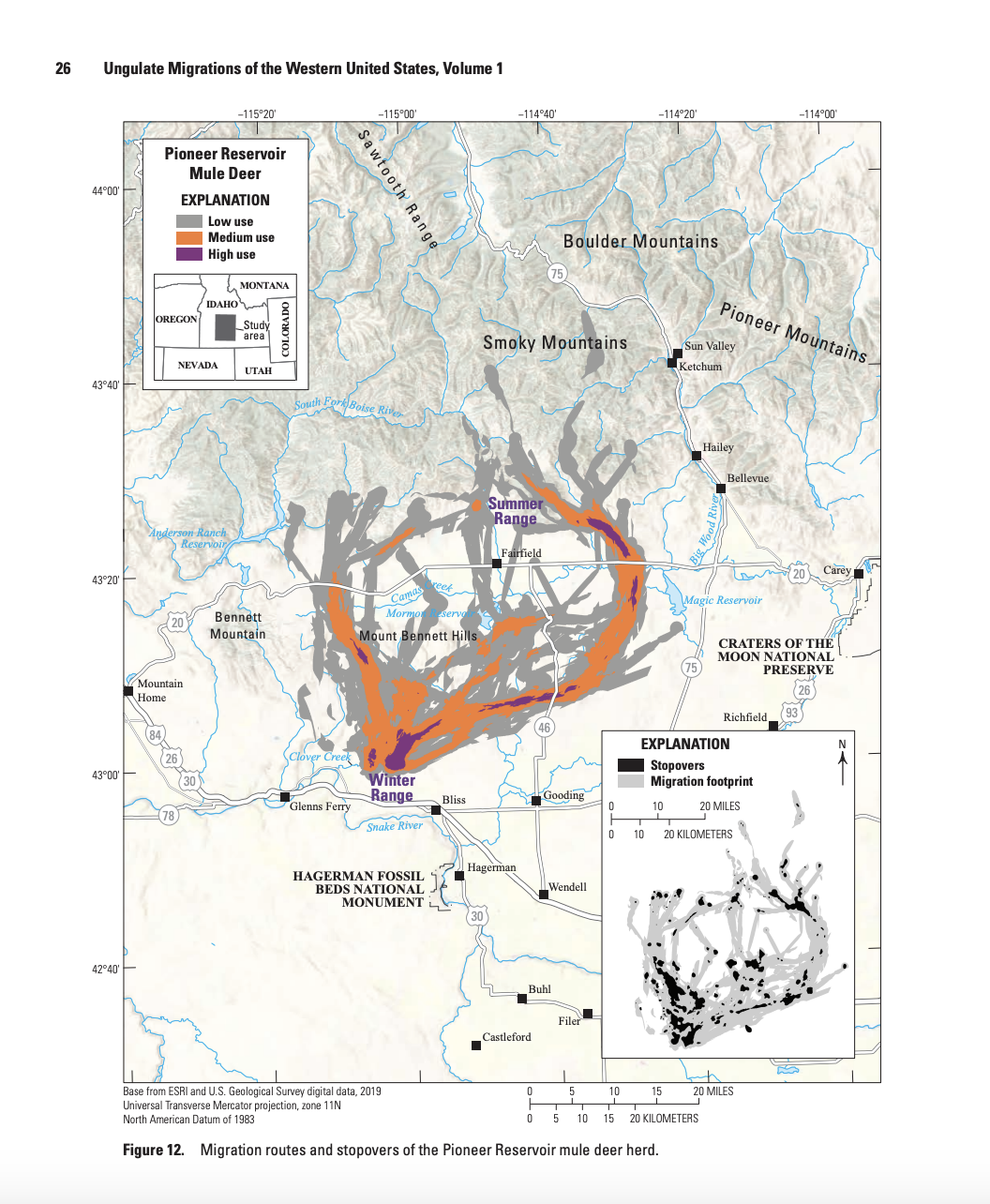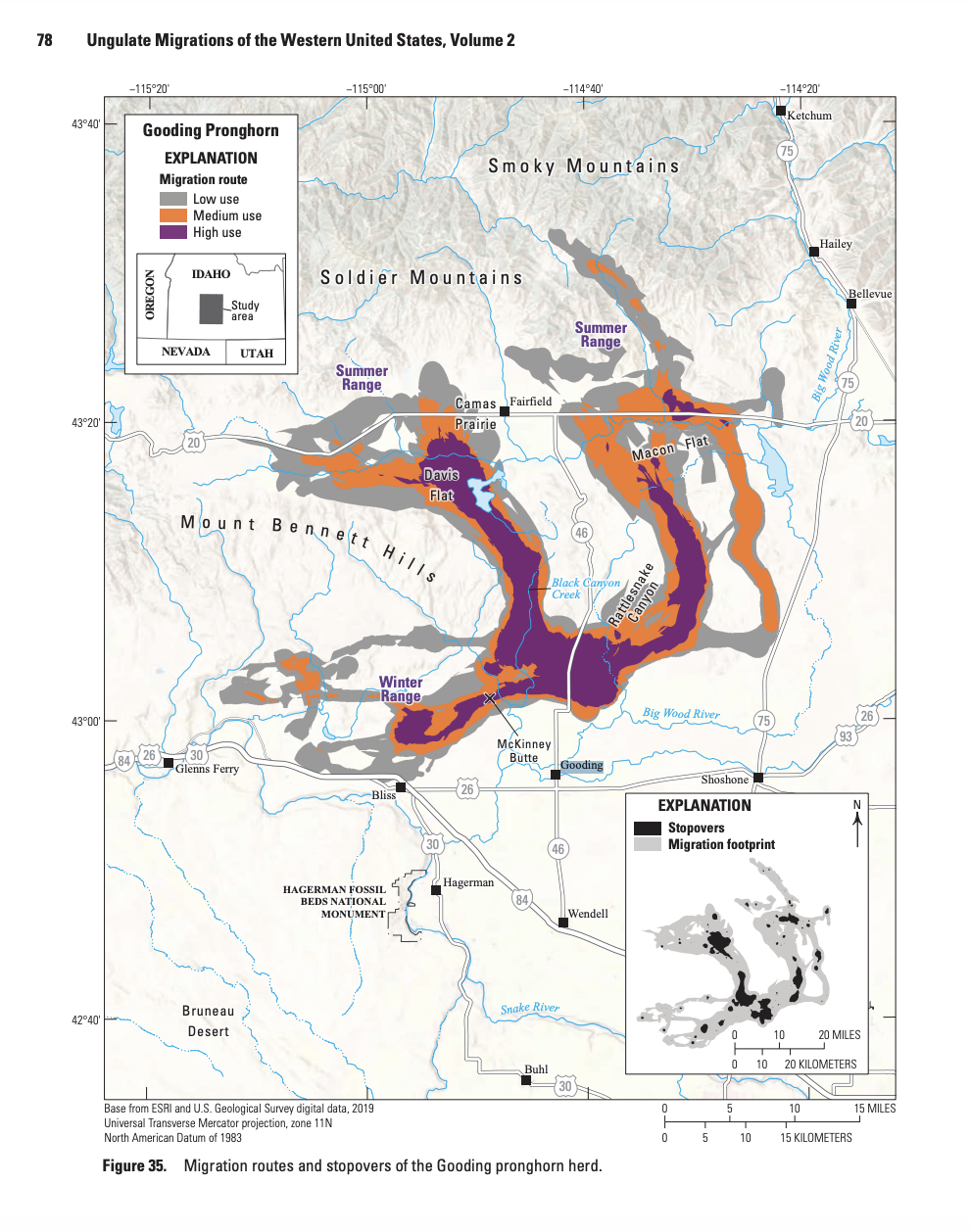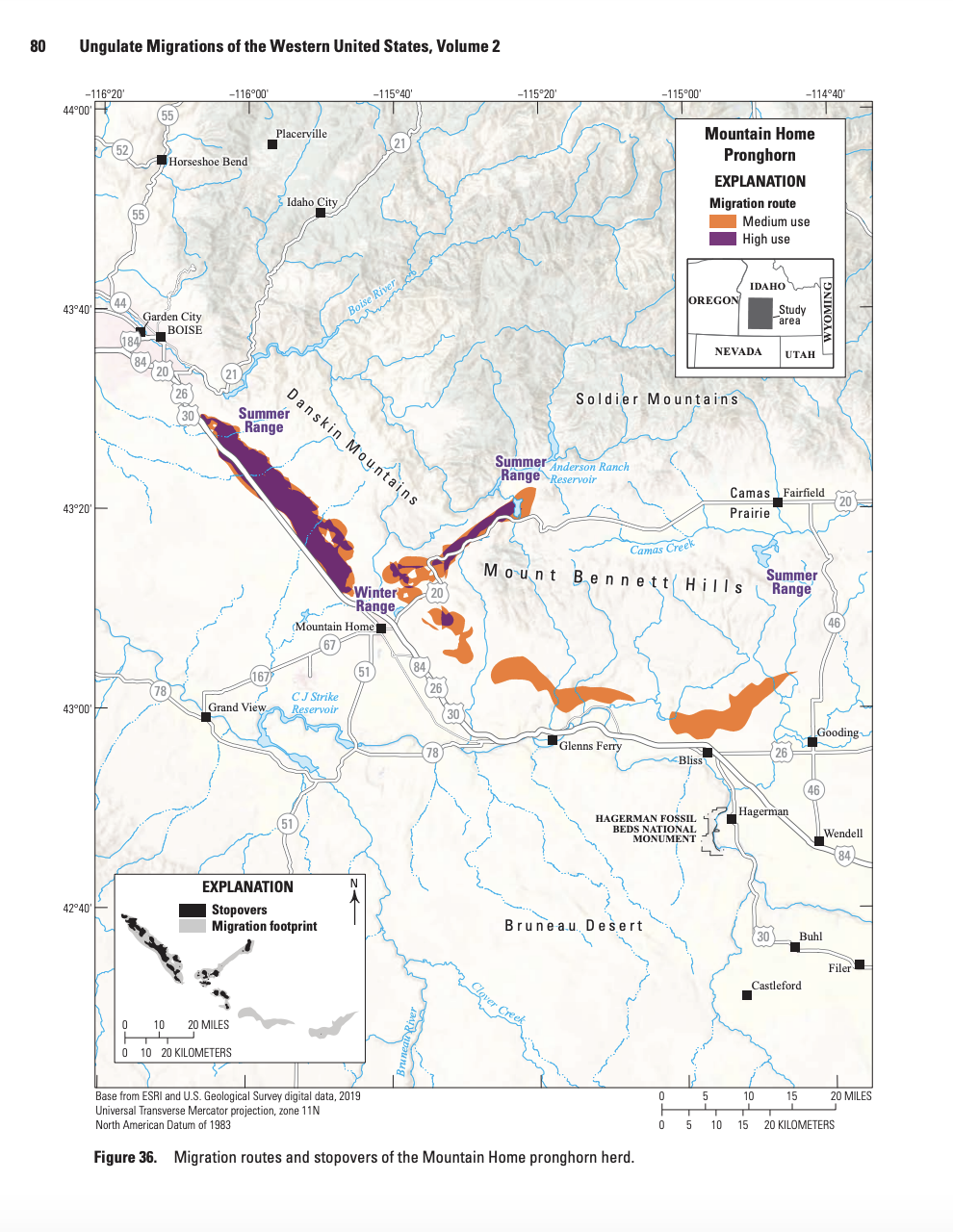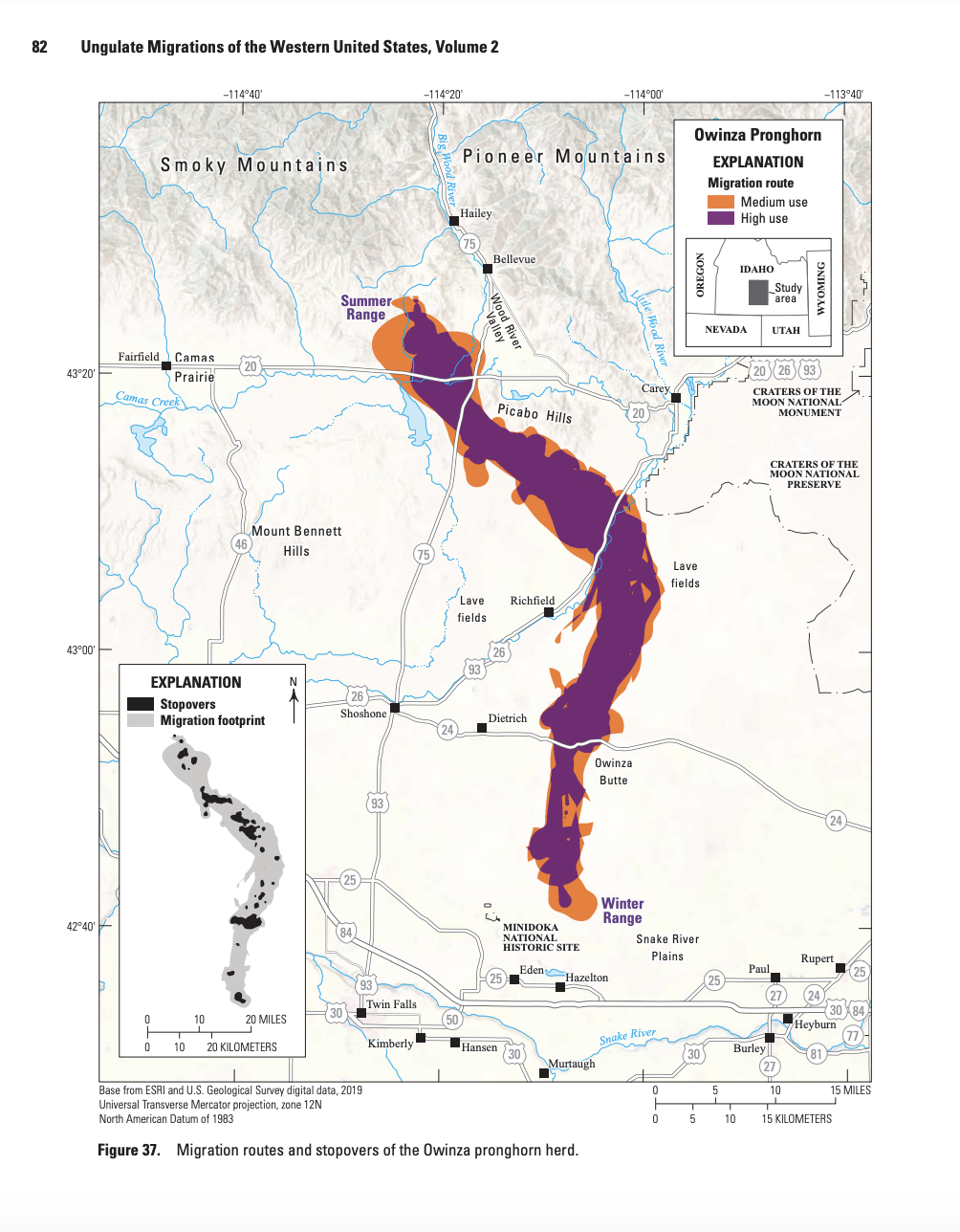Conserving Big Game Migrations In the Face of Renewable Energy Development
The Snake River plain is prime winter range for thousands of deer, elk, and pronghorn, historic lekking grounds for imperiled sage-grouse, and habitat for over 350 other species. But as – for example – you drive along I-84, likely with a crosswind ripping across the Bennett Hills, you’ll see solar and wind farms have also rooted themselves into the landscape on private lands. Will they make it onto adjacent public lands too?
Renewable energy companies have set their eyes on Southern Idaho for a number of reasons. The Twin Falls District BLM office is juggling almost a dozen wind and solar project applications. Project proponents cite the BLM’s lack of updated resource management plans that reference renewable energy generation, Idaho’s friendly regulations towards energy development, and rapidly developing renewable energy technology that makes this landscape viable for utility scale development.
However, we are not alone. The U.S. Energy Information Agency (EIA) forecasts a 62% increase in renewable energy generation by 2030.* This projected buildout will entail a more than 3-fold increase in solar and a 33% increase in onshore wind.** This will take a lot of land. According to a Princeton study, under a net zero scenario that does not rely on nuclear energy and natural gas with carbon capture, the U.S. energy footprint quadruples in size.*** (Check out National Wildlife Federation’s overview of this in their Guide for Responsible Development of Wind and Solar here).
This projected buildout may very well become a reality. The Energy Act of 2020 directs the Secretary of Interior to “seek to issue permits” for wind, solar, and geothermal energy projects on public lands to produce at least 25 gigawatts of electricity by 2025.” On top of this, many western states and energy providers have also set ambitious clean energy goals.
While it is clear that we must take steps towards addressing the effects of climate change, it does not have to be at the expense of wildlife diversity, habitat connectivity, and natural ecological function. Energy development can alter movement and behavior of big game animals, disrupt their use of habitat through fragmentation, noise, increased human traffic, fencing, and removal of vegetation. There is evidence that ungulates do not habituate to this increased activity and continue to forego important habitat to avoid development.****
So,how do we conserve wildlife migrations and sensitive wildlife habitat in the face of a booming interest in renewable energy development in Idaho?
We have come a long way in recent years in understanding the movements and migration of our valued big game, in large part thanks to the efforts of Idaho Department of Fish and Game and Secretarial Order 3362. Idaho has over 50 mapped migrations illustrating the feat of thousands of animals traveling upwards of 100 miles each spring and fall to reach favorable habitat and avoid harsh conditions. We can use these mapped migrations as a tool to inform land managers and energy developers about the most valuable areas in order to prioritize development outside of these migration pathways and critical winter ranges.
Migration can be best thought of as a form of culture within herds. Recent science has revealed that knowledge of when and where to migrate is passed on from mothers to offspring. They’ve learned over generations precisely where and when forage will green up when it is most nutritional, and to anticipate where it will spring up next. . If we interrupt or fragment migration corridors, herds are cut off from the generational pathways that have kept them alive. That generational knowledge is no longer passed onto offspring, and that can be the beginning of the end of herds. The decades it will take to learn new migration pathways is likely to be a nearly impossible task.*****
To preserve migrations and ensure the wellbeing of Idaho’s big game herds,, land management plans must incorporate strategies that conserve migration corridors.
So, What’s Happening Right Now?
Currently, the BLM is updating its Western Solar Plan to identify BLM lands where solar development is likely to encounter fewer resource conflicts and make those lands available for application for solar development across 162 million acres in 11-western states. The BLM’s preferred alternative amends resource management plans to allow for the potential for solar development across a total of 1.47 million acres of BLM-managed land in Idaho.
As written, the draft Western Solar Plan excludes solar development from big game migration corridors and winter ranges only where they are identified in existing land use plans. Unfortunately, most of Idaho’s resource management plans are severely outdated and provide no acknowledgment and/or management direction for big game migrations or winter range. For example, the Twin Falls Management Framework Plan was developed in 1982, has no reference of migration corridors, and has not been updated to reflect the new science and mapped of dozens of big game migration routes in Idaho.
If the BLM selects its preferred alternative, solar energy projects could potentially find their roots across thousands of acres of wildlife migration routes. In Southern Idaho, that may mean solar overlapping with 24,000 acres of migration habitat and winter range for the Pioneer Mountain mule deer herd, 60,244 acres overlapping with the Gooding pronghorn migration, 102,000 acres overlapping with the Mountain Home pronghorn migration, and 264,792 acres overlapping with the Owinza pronghorn migration. Check out these incredible migrations showcased through the USGS Ungulate Migrations of the Western United States Volumes 1, 2, and 3 below.




IWF has spent years advocating to avoid energy development in migration pathways and winter range. We are continuing this push through the Western Solar Plan.
We have the best available science- it needs to put it into practice by excluding mapped migrations from solar development in the BLM’s Western Solar Plan.
Stay up to date with our work through idahowildlife.org
*See U.S. Energy Information Agency, 2022 Outlook at Table 8 Electricity Supply, Disposition, Prices, and Emissions (Mar. 3, 2022), https://www.eia.gov/outlooks/aeo/tables_ref.php.
**See id. at Table 16. Renewable Energy Generating Capacity and Generation.
***Princeton University, Net-Zero America (Jan. 1, 2023), https://netzeroamerica.princeton.edu/the-report.
****Ungulate Migrations of the Western United States, Volume 1. https://pubs.usgs.gov/sir/2020/5101/sir20205101.pdf p. 3
*****Ibid.


